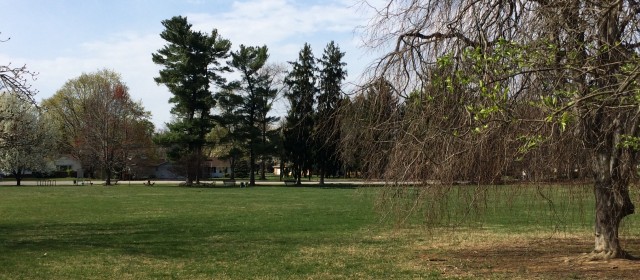Timeline | Thornwald Estate | Public Ownership| Debate over use | Converted mansion into retirement home | Dedication of Thornwald Park |The amphitheater | The land | Historical Resources|Photo Gallery
School or park?
Between 1972 and 1975, debates arose among the town residents, the Carlisle Borough and the School District over the construction of a school on the Homewood Site. The residents did not want to see a natural area of the city be replaced by a concrete structure and filled with noise disturbance. The Borough was pushed to purchase the land and did so with the help of a “preservation type” $350,000 grant. The school was never built, and the park remained an “untouched” green space for the residents of Carlisle.
This coincides with the rise in “open space” preservation movements, an important process within the environmental movement of the post-war era (1). Although suburbanization provided homes and “individual parks” in the form of back and front yards, it also destroyed the ability to conserve, the authenticity of the landscape, and communal outdoor spaces (2). The fact that Thornwald’s preservation efforts coincided with this movement is no coincidence. Carlisle began to undergo change as farmland and older, massive estates were broken down into new development projects. Citizens of Carlisle realized the importance of Thornwald and sought to preserve it as means to restore authenticity to the landscape and provide grounds for all to enjoy.
Citizens to Preserve Thornwald vs. Friends of Thornwald
Around 1979, two organizations were created to preserve Thornwald, but their aspirations for the park differed in many ways.
After the Carlisle Borough bought the park from the School District, renovation projects were not put aside, as the City planned to include structures such as an ampitheater, a paved parking area, paved trails and picnic pavilions (3). Those “improvements” made upon the park land were supported by the Friends of Thornwald organization, and rejected by Citizens to Preserve Thornwald. The latter organization refused to alter the natural beauty of the park and to bring noise disturbances, littering, cars, and crowds of children in the park.
(1) Adam Rome, The Bulldozer in the Countryside (New York, NY: Cambridge University Pressm 2001), 120.
(2) Ibid, 123.
(3) Newspaper article: “Thornwald Development Challenged”, Feb 28, 1979. Carlisle Parks and Recreation Dept.

